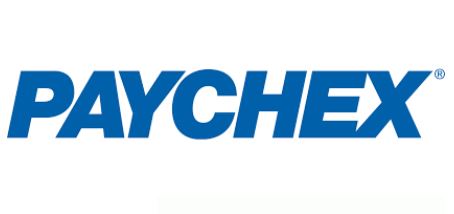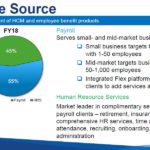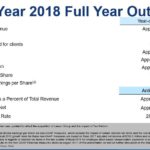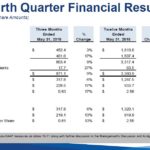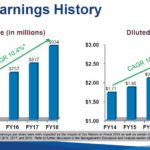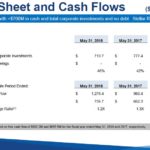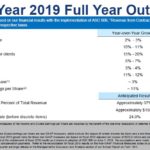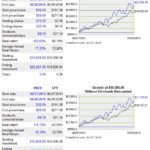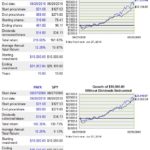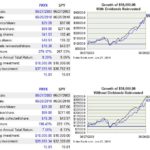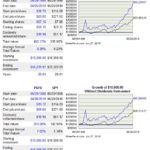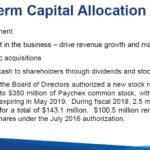Contents
Introduction
My wife and I had the good fortune of being able to retire in our early and mid 50s and we certainly have no desire whatsoever to return to the workforce to make up for foolish investment mistakes. As a result, my investment strategy, risk tolerance, and goals and objectives are such that I seek to invest in well managed companies where wild swings in quarterly and annual results are an anomaly. In addition, I am not a yield chaser and prefer to look at potential overall returns a company can generate as opposed to focusing extensively (exclusively?) on dividend income / dividend yield.
Given the above, I strive to invest in companies which consistently show a reasonable compound annual growth rate in various key metrics such as Net Income, Operating Income, Diluted EPS, and Dividend growth.
I am a long-term buy and hold type investor and am inclined to just hold investments even if they experience a rapid appreciation in value and crystallization of the gain might be prudent; I am fully aware of the tax implications of frequently buying and selling investments and decided years ago to adopt the Buffett and Munger style of investing where portfolio turnover is kept to a minimum so I don’t get bent out of shape if stocks prices decline significantly on the condition the decline is not the result of some permanent impairment to the underlying business.
My investment style is like ‘watching paint dry’ so if your preference is to be an active trader, this article may not be of interest to you. If generating decent long-term investment returns while expending minimal time and effort appeals to you, however, then read on as Paychex (NASDAQ: PAYX) could help you achieve your long-term goals and objectives if management can replicate the company’s historical performance.
This article is a follow up to my March 27 article for Financial Freedom is a Journey subscribers. In that article I reviewed the company’s Q3 2018 results which were released March 26. I indicated that shares were attractively valued based on management’s guidance for FY2018 and retracement in the company’s stock price to $61.22 on March 26 from the ~$73 12-month high stock price set January 23.
In keeping with my disclosure in that article, I acquired 400 shares @ $60.6699/share for the FFJ Portfolio on March 27. Subsequent to my purchase, PAYX’s stock price waffled in the low $60s but then proceeded to run up to a recent ~$70 range.
While many readers may not need to contend with foreign exchange conversion rates, my PAYX purchase necessitated the need to convert CDN to USD. At the time, the CDN dollar/US dollar foreign exchange rate of ~1.28:1 was not attractive but I envisioned some headwinds for the CDN dollar in the coming months and suspected it would weaken relative to the USD. As I compose this article, the foreign exchange conversion rate is ~1.327:1. In my opinion, the CDN dollar will likely continue to experience weakness over the next several months.
On June 27, PAYX released its Q4 and FY2018 results and provided guidance for FY2019. The stock has pulled back slightly, and therefore, I am taking this opportunity to revisit PAYX to determine whether I should add to my position.
PAYX’s Business Mix
PAYX’s mission is to be the leading provider of Human Capital Management (‘HCM’) solutions for payroll, HR, retirement, and insurance services for small- to medium-sized businesses by being an essential partner with America’s businesses.
In this regard, it offers a comprehensive portfolio of HCM services and products that allow clients to meet their diverse payroll and HR needs. Its clients can select services on an á la carte basis or as part of various product bundles. Using the information gathered in the base payroll processing service, PAYX can offer payroll-related ancillary services and Human Resource Service (“HRS”) offerings thus enabling it to cover the HCM spectrum.
In FY2009, PAYX generated $523.6MM in HRS revenue versus $1.5B in payroll service revenue. As you can see from the following images, HRS revenue has appreciated considerably since FY2009 to the extent where the variance in annual HRS and payroll revenue is only ~$0.3B
Source: PAYX Q4 2018 Highlights and Financial Results
Q4 and FY2018 Results
PAYX’s Q4 2018 results can be found here.
I like to look at back to see how a company has performed relative to previously provided guidance. This is the guidance upon which I relied when I initiated my PAYX position.
Source: PAYX Q3 2018 Highlights and Financial Results
These are the actual results for FY2018.
Source: PAYX Q4 2018 Highlights and Financial Results
In my opinion, actual full year financial results should deviate very little from full year guidance provided in Q3 unless there is some catastrophic event which management could not have foreseen. As you can see when you compare projections provided at the end of Q3 and FY2018 actual results, PAYX achieved what management had projected.
FY2019 Guidance
The following is PAYX’s FY2019 guidance.
Source: PAYX Q4 2018 Highlights and Financial Results
The reduction in the YoY growth in net income and adjusted net income is the result of the benefit of the one-time revaluation of deferred tax liabilities that was recognized in FY2018 resulting from the Tax Cut and Jobs Act. The reduction in the YoY growth has nothing to do with any deterioration in the business.
Potential Impact of Tariffs on PAYX
Recently, the US Federal Government has imposed tariffs on foreign imported goods. This has triggered retaliatory measures by foreign countries. While large multi-national corporations will be negatively impacted I suspect they will find ways to adapt. I am not so confident, however, that small- and medium-sized US businesses which conduct business on an international basis will be able to easily adapt. Since PAYX focuses on small- and medium-sized businesses I suspect PAYX will be negatively impacted.
In my opinion, I think these recently introduced tariffs (and retaliatory tariffs) will be short-lived. We now live in a global economy and to think that a country can operate in isolation is naïve and short-sighted. Once US companies and citizens begin to feel the negative monetary impact of these recently imposed tariffs and displeasure over same becomes more widespread, I anticipate removal and/or relaxation of tariffs will occur. I have no idea when this will occur but strongly suspect it will happen before the next US Presidential election.
It would not surprise me if PAYX has reached out to many of its clients to determine the extent to which they think they will be impacted by reason of these recently imposed tariffs; I think it would not be unreasonable for PAYX to revise its FY2018 projections as the year progresses. If my hunch is correct, I think PAYX’s stock price will likely be range bound and to expect a dramatic increase in its stock price is ill-advised.
Credit Ratings
I typically devote a section of my analysis to the assessment of the company’s credit risk by touching upon the Moody’s and S&P Global credit ratings. In the case of PAYX….neither ratings agency assigns a credit rating because…there is no long-term debt!! This greatly appeals to me.
Free Cash Flow (FCF)
PAYX consistently generates strong FCF. Morningstar reports FY2008 – FY2017 results for this metric as follows: $0.725B, $0.689B, $0.611B, $0.715B, $0.707B, $0.675B, $0.880B, $0.895B, $1.018B, and $0.960B.
The manner in which Morningstar calculates FCF differs slightly from PAYX as PAYX reflects FY2017 FCF of $0.8575B ($0.960B from Morningstar). PAYX reports FY2018 FCF of $0.9022B.
PAYX’s consistently strong FCF results appeal to my conservative investment style.
Valuation
At the time of my March 26 article, I projected ~$2.55 in diluted EPS (a 13.5% increase from FY2017) and ~$2.54 in adjusted diluted EPS (a 15.5% increase from FY2017). The stock was trading at $61.22 when I wrote the article thus resulting in a forward PE of ~24 based on projected diluted and adjusted diluted EPS.
PAYX has now reported diluted EPS of $2.58 and adjusted diluted EPS of $2.55 and has forecast a ~3% increase in diluted EPS and a ~11% increase in adjusted diluted EPS for FY2019 relative to FY2018. On this basis, management is projecting ~$2.66 diluted EPS and ~$2.83 adjusted diluted EPS for FY2019.
With PAYX trading at $66.89 as at the close of business on June 27, we arrive at a forward diluted PE of ~25.15 and a forward adjusted diluted PE of ~23.64.
PAYX typically trades in excess of these levels; its PE based on diluted EPS has generally been in excess of 26 from 2013 – 2018. During 2008 – 2012, PAYX’s PE was in the mid teens to lower 20s.
If you have any interest in acquiring shares in this high quality company, I think you will be waiting an extremely long time for its valuation to retrace to that of the broad index (current S&P500 PE of ~20.5). In all the years I have followed PAYX I do not recollect seeing PAYX’s PE below that of the S&P500.
On April 27, PAYX announced that its Board of Directors had approved a $0.06 increase in the regular quarterly dividend (a 12% increase); the $0.56/share dividend was distributed on May 24. I was surprised by this early announcement as PAYX has typically increased its dividend in August in recent years.
Based on a $2.24 annual dividend and the current $66.89 stock price, we get a ~3.35% dividend yield. While this dividend yield is attractive I caution Canadian readers to be cognizant of the 15% withholding tax if shares are held in a non-registered account, Tax Free Savings Account, or Registered Education Savings Plan.
As previously noted, PAYX’s guidance is for ~$2.66 diluted EPS and ~$2.83 adjusted diluted EPS for FY2019. On this basis, the projected $2.24 annual dividend represents a ~84% payout ratio using projected diluted EPS and ~79% on projected adjusted diluted EPS. These levels are high but are consistent with historical payout ratios. Furthermore, the nature of PAYX’s business and the manner in which the company is operated enables the Board to maintain a high dividend payout ratio without negatively impacting the company’s ability to grow. In PAYX’s June 27, 2018 Press Release, management indicated that:
‘Our positive cash flows have historically allowed us to support our business and to pay substantial dividends to our stockholders. It is anticipated that cash and total corporate investments as of May 31, 2018, along with projected operating cash flows and available short-term financing, will support our normal business operations, capital purchases, share repurchases, dividend payments, and business acquisitions, if any, for the foreseeable future.’
PAYX’s stock split history can be found here. I tip my hat to PAYX shareholders during the 1986 – 2000 timeframe…ten 3 for 2 stock splits!
While future performance is not guaranteed to be similar to historical performance, I nevertheless would much prefer to invest in a company whose shareholders have been aptly rewarded over an extended period of time than to invest in a company where shareholder returns have lagged the S&P500.
If we look at how PAYX shareholders have fared over various time frames, we see that PAYX’s returns versus those of the S&P500 vary significantly depending on the timeframe analyzed. In my opinion, I think PAYX’s current valuation will present investors with an opportunity to generate reasonable long-term returns. Having said this, I previously noted the possibility of negative repercussions from recently imposed tariffs on some of PAYX’s customers. On this basis, I am inclined to exercise patience and to wait for a pullback in PAYX’s stock price.
Source: Tickertech.com
In my March 27 article I indicated that during the first 9 months of FY2018, PAYX repurchased 1.6 million shares for a total of $94.1 million. For the entire FY2018, PAYX repurchased 2.5 million shares of common stock for a total of $143.1 million. During both the 9 month and full year periods in FY2017, PAYXrepurchased 2.9 million shares for a total of $166.2 million.
Despite share repurchases, the diluted weighted-average common shares outstanding has remained relatively stable at ~362 million (give or take 1 or 2 million shares) since at least FY2009.
Unlike many publicly listed companies which have loaded up on inexpensive long-term debt to repurchase shares at what are sometimes lofty valuations, PAYX has repurchased shares using earnings generated from normal business operations. I am comfortable with PAYX’s long-term capital allocation practice and do not expect it to deviate from the following:
Source: PAYX Q4 2018 Highlights and Financial Results
Final Thoughts
While I indicated earlier in this article that I recently initiated a position in PAYX, it is not the first time I have held shares in the company.
I acquired shares in PAYX on July 8, 2009 at $24.9399 for our daughter’s Registered Education Savings Plan but sold these shares April 19, 2017 at $58.05 to cover some of her education related expenses. I fully intended to repurchase these shares in a non-registered account but ended up purchasing shares in another company.
I have always been impressed with the company so despite the uncertainty surrounding the magnitude of the negative repercussions from recently imposed tariffs on PAYX’s customer base, I am confident management will be able to navigate its way through what may be some difficult economic conditions over the foreseeable future.
PAYX’s pristine balance sheet plays no small role in making me feel the way I do; I think highly leveraged companies with weak free cash flow are likely to experience some extreme challenges in the not too distant future.
If PAYX experiences another pullback to the level at which I recently acquired shares, I would be open to increasing my position. Having said this, it goes without saying that I would need to evaluate the benefit of acquiring additional PAYX shares as opposed to shares in other companies which may be more attractively valued.
I wish you much success on your journey to financial freedom.
Thanks for reading!
Note: I sincerely appreciate the time you took to read this article. Please send any feedback, corrections, or questions to charles@financialfreedomisajourney.com
Disclaimer: I have no knowledge of your individual circumstances and am not providing individualized advice or recommendations. I encourage you not to make any investment decision without conducting your own research and due diligence. You should also consult your financial advisor about your specific situation.
Disclosure: I am long PAYX.
I wrote this article myself and it expresses my own opinions. I am not receiving compensation for it and have no business relationship with any company whose stock is mentioned in this article.


